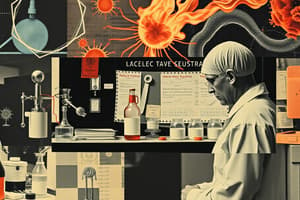Podcast
Questions and Answers
What is the purpose of re-streaking a colony on a fresh solid medium?
What is the purpose of re-streaking a colony on a fresh solid medium?
- To speed up the growth of multiple colonies
- To observe the growth rate of colonies
- To introduce contaminants to the culture
- To obtain a pure culture by isolating a single colony (correct)
Why is colony morphology considered a crucial aspect of colony purification?
Why is colony morphology considered a crucial aspect of colony purification?
- It influences the choice of medium for culture growth
- It affects the time of incubation required
- It indicates the purity of the culture (correct)
- It changes the agar concentration in the medium
What factor does agar concentration affect during colony purification?
What factor does agar concentration affect during colony purification?
- Colony morphology (correct)
- Time of incubation
- Choice of medium
- Temperature of incubation
Why is distinguishing between similar morphologies challenging during colony purification?
Why is distinguishing between similar morphologies challenging during colony purification?
What can misidentification of microorganisms during colony purification lead to?
What can misidentification of microorganisms during colony purification lead to?
Why is time of incubation considered crucial in selecting well-isolated colonies?
Why is time of incubation considered crucial in selecting well-isolated colonies?
Who were the researchers that demonstrated the importance of solid media for isolating pure cultures of bacteria and fungi in the 1920s?
Who were the researchers that demonstrated the importance of solid media for isolating pure cultures of bacteria and fungi in the 1920s?
What significant improvement did agar bring to microbiology in the early 20th century?
What significant improvement did agar bring to microbiology in the early 20th century?
Why is colony purification on solid media considered crucial in microbiology?
Why is colony purification on solid media considered crucial in microbiology?
What was the main challenge with liquid media that was improved upon by using solid media for colony purification?
What was the main challenge with liquid media that was improved upon by using solid media for colony purification?
What is the primary purpose of colony purification on solid media?
What is the primary purpose of colony purification on solid media?
How did agar contribute to the development of microbiology in the early 20th century?
How did agar contribute to the development of microbiology in the early 20th century?
Flashcards are hidden until you start studying
Study Notes
Colony Purification on Solid Media
Colony purification is a fundamental technique used in microbiology to isolate and obtain a pure culture of a single species from a mixed population of microorganisms. This process is crucial for further study and identification of microorganisms, as well as for applications such as biotechnology and pharmaceuticals. The method we'll focus on here primarily involves the use of solid media.
Historical Context
The concept of purifying colonies on solid media originated in the early 20th century, following the development of agar, derived from seaweed, as a solidifying agent for nutrient broths. Agar allowed microbiologists to prepare a solid growth surface for microorganisms, which was a significant improvement over liquid media, as colonies were easier to observe and manipulate.
The first reports of solid medium applications for colony purification appeared in the 1920s, when researchers such as Selman Waksman and Rene Jules Dubos demonstrated the importance of solid media for isolating pure cultures of bacteria and fungi.
The Process
Typically, colony purification on solid media involves the following steps:
- Preparation of a mixed culture: This involves inoculating a solid medium with a sample containing a mixture of microorganisms.
- Growth of colonies: The mixture is incubated, and microorganisms with similar nutritional requirements form distinct colonies.
- Selection of a colony: A single, well-isolated colony is chosen for further analysis.
- Re-streaking: The selected colony is transferred to a fresh solid medium to create a new, single colony.
This process is repeated until a pure culture is obtained, which is characterized by a single morphology and is free from contaminants.
Factors Affecting Colony Purification
Several factors influence the success of colony purification on solid media. These include:
- Choice of medium: The composition of the solid medium needs to provide optimal nutritional conditions for the microorganism of interest.
- Incubation conditions: Temperature, humidity, and type of incubator all affect the growth rate and morphology of microorganisms.
- Time of incubation: Length of incubation affects the size and morphology of colonies, which is crucial for selecting well-isolated colonies.
- Agar concentration: Too little agar may result in a liquid medium, while too much agar may inhibit growth.
- Colony morphology: The appearance of a colony is a crucial indicator of its purity.
Challenges and Considerations
Although colony purification on solid media is a widely used technique, it does have its limitations and challenges:
- Colony morphology: Distinguishing between similar morphologies can be challenging, and microbiologists may need to examine additional physiological and biochemical characteristics to confirm the purity of a culture.
- Colony variants: Colonies can sometimes develop variations in morphology, requiring additional purification steps.
- Incorrect identification: Misidentification of microorganisms can lead to incorrect conclusions and the dissemination of misinformation.
Despite these challenges, colony purification on solid media remains a critical technique in microbiology, providing the basis for further research and applications.
Studying That Suits You
Use AI to generate personalized quizzes and flashcards to suit your learning preferences.




